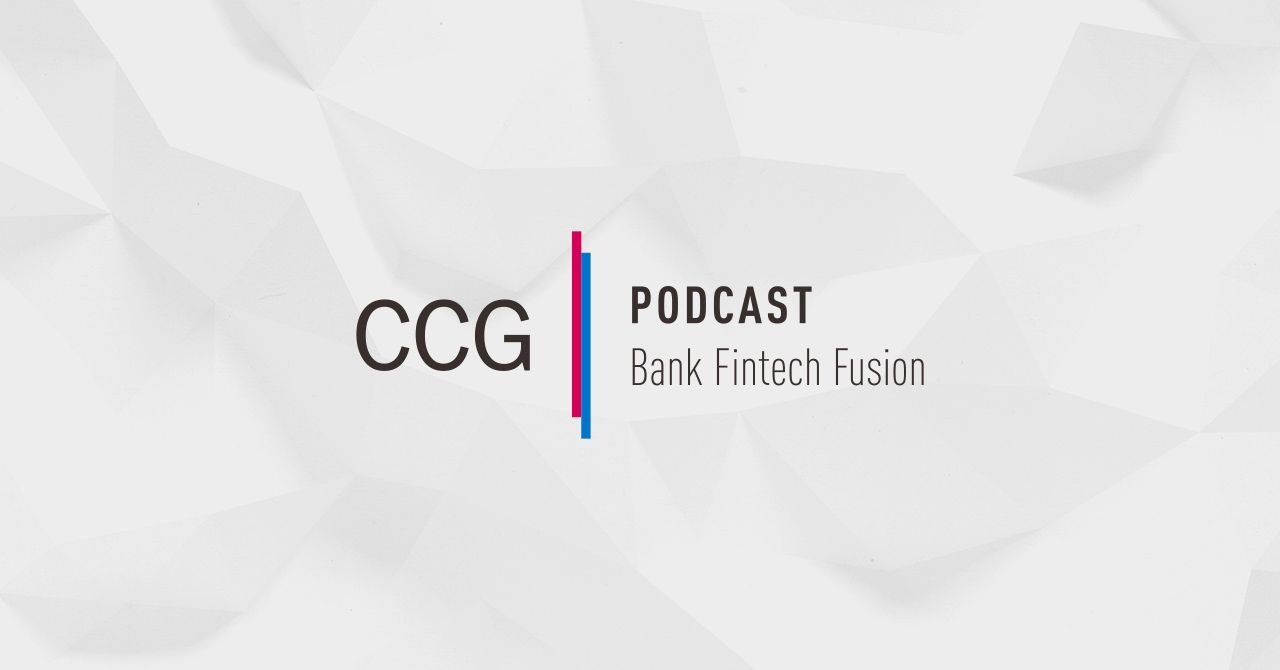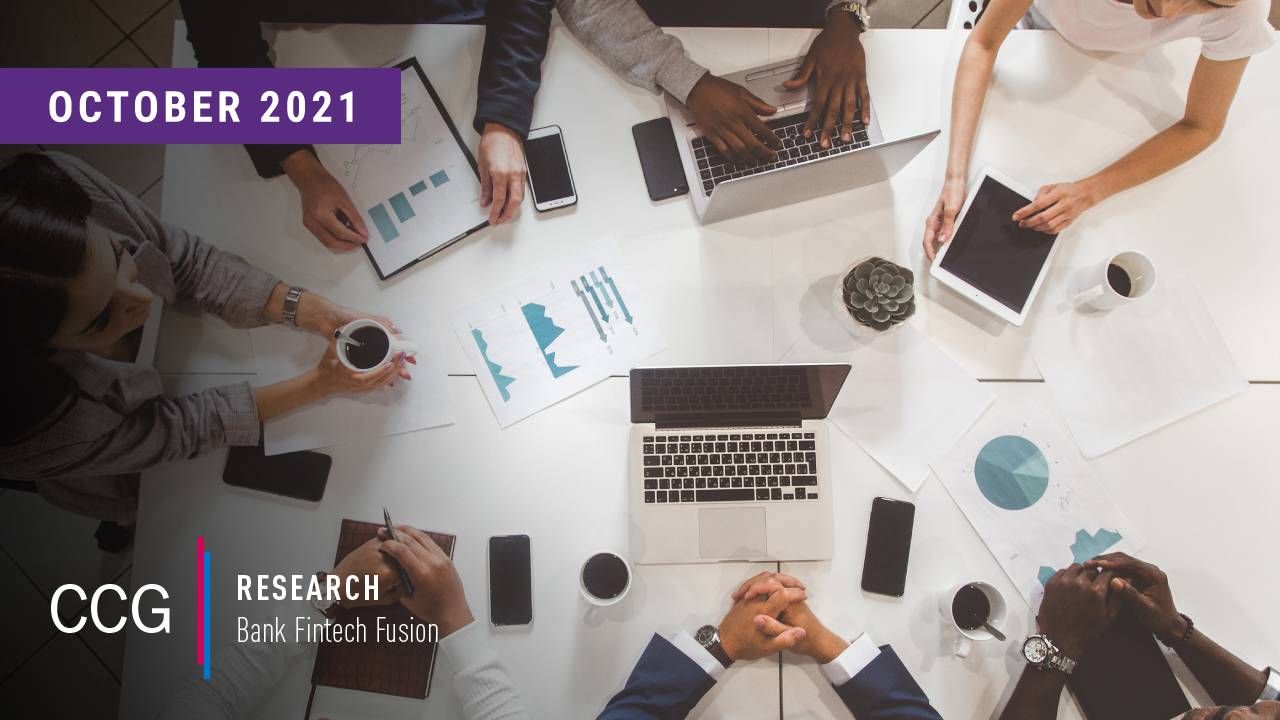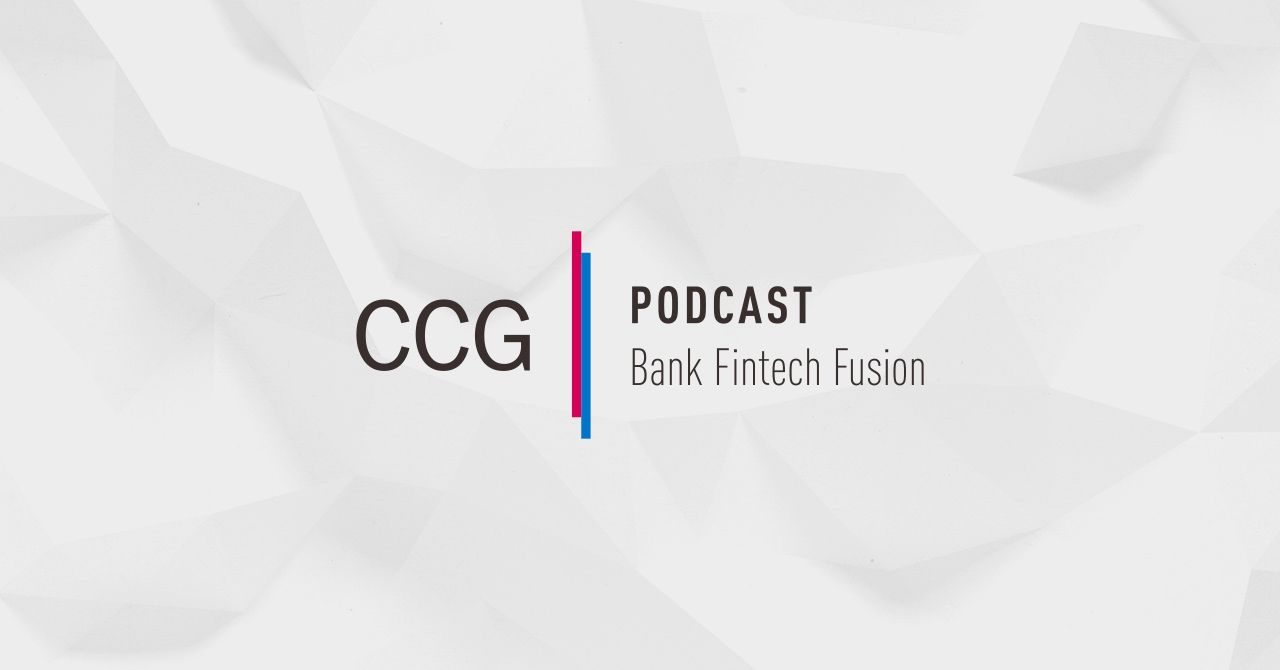Capital One: Building New Tools to Empower the Customer
Tom Poole, senior vice president for payments and identity at Capital One, spoke with CCG Catalyst‘s Scarlett Sieber at Money20/20 in Las Vegas. Their wide-ranging discussion touched on aspects of mobile payments and the key role of authentication in the process, as well as the bank’s strategies around top-of-wallet. Poole has been a leader in the mobile payments space since their emergence, and he is optimistic about their growth and the advantages they bring to the customer. Much of Capital One’s work in the digital space is centered around empowering customers to spend smarter and become more financially secure.
Read the full transcript here:
Scarlett Sieber [00:00:02] Welcome back to Bank FinTech Fusion. I am your host, Scarlett Sieber, and we have an incredible guest. We’re here at Money 20/20 and I am sitting next to the incomparable Tom Poole, who is Senior Vice President for Payments, Identity and Capital One Labs at Capital One.
Tom Poole [00:00:19] It’s a big title. Yes. There’s no good acronym for it, I can assure you.
Scarlett Sieber [00:00:23] So I’ve had the distinct pleasure of hearing about you and watching your talks for many years now. And I think it’s so interesting to see how the industry at large has evolved and really what Capital One has been doing. So from your perspective, what drew you to financial services? And when you think about that, was there a particular problem you set out to solve?
Tom Poole [00:00:45] So I have been in financial services now for 20 years. And so when I think about what drew me and I go back 20 years is probably also the thing that kept me is that central to people’s lives, there’s just so many things that are unlocked, enabled by the ability to move, use gainfully employed, the money that people have in their hands. And it’s the pathway to doing most of what they want to do in life in some form or other requires payments specifically. And that’s such a rich experience. Yet there’s so much friction, there’s so many challenges in it. There are so many lack of available tools for a lot of the US population where they just can’t do what they need to do effectively. A lot of people can’t even access e-commerce because they don’t have the tools to do that effectively and safely. And so to me, that’s just an incredible problem to have a chance to help solve, to reduce the friction and reduce the fraud, to make the payments easy, fast, frictionless. And that’s never gotten old in 20 years.
Scarlett Sieber [00:01:39] So I feel like every given day there’s something new in the news about what’s happening in our industry from your view. Can you describe the greatest challenge to your organization right now?
Tom Poole [00:01:51] So for my part of the organization, I think the biggest challenge is how do we do more with what we get from consumers today? So we do in terms of the services we provide back. So we spent an enormous time taking friction out of the standard processes that our consumers use. But I think we have this chance to go a step further to really help them make sense of how they’re spending their money. And it’s a big data problem. It’s a machine learning problem. It’s a striking the right balance of helping consumers understand that without in any way being patronizing or suggesting they shouldn’t have bought those shoes, they shouldn’t have made that last purchase. But just give them that understanding, because I think with that knowledge comes power. And that’s the real threshold that I think no bank has really unlocked in the richness in the way they should. We’re still giving you lists of transactions, but not making sense of it. How much did I spend on the bar trip last night? How do I compare to people around me? Hey, there’s a gift giving occasion coming up. Last year, you bought flowers right before Valentine’s Day. Maybe you want to do that again. I mean, these are the small and large things that we could really help our customers with. We have all the data to do it. But again, it’s an enormous big data machine learning problem to find those insights strike the right balance between useful information and not creepy and deliver that value back to our customers.
Scarlett Sieber [00:03:04] Yeah, I always talk about the impact and importance of data. And as you said, it’s something that is fundamentally transforming in our industry. But there’s still a long way to go. And I love the idea of knowledge is power, too, because, you know, this conversation, as you said, is certainly not a new one. And it’s not about shaming these people, but it’s about connecting them with them where they are and understanding the emotional impact of a lot of this stuff. Because even though I know I have ten dollars in my bank account, it’s my kid’s birthday. I’m still going to go get that cake. you know what I mean. You know, it’s going to charge I’m going to charge more money. So I think there’s something that’s really fundamental there that we need to help think through is the emotional impact as well. So that the topic of this podcast is always around bank and fintech fusion. So from your perspective, what is key to banks and fintech working together effectively?
Tom Poole [00:04:00] I think there’s a couple of dimensions to that relationship. One, I find the most successful fintechs are just religious about a problem that they have found and they’re setting out to solve it. And they have a purity of focus that I think large institutions would struggle to do just because there’s so many things on the agendas of a large institutions, so many things they have to balance so many constituencies. They have to manage what a fintech, what really good fintech have luxury to do is sort of stare at a really real concrete pain point for consumers and set out to build solutions that address that and really thoughtful and innovative ways, because oftentimes the system is not serving, it’s not serving the consumer in the way it should be. And so I think the partner some of the partnership comes when that opportunity is simply exposed to the rest of the industry, that the fintech can make that an issue such that the industry gets better as a whole, whether it ends at an acquisition of the fintech, whether there’s consumption of services by the industry. I think that’s that’s one great win area. You know, the other one that we have found consistently is there are certain types of technologies. It just wouldn’t make sense for a single bank to build, facial recognition technology, liveness detection, things like those. The best business model is going to be a single company that perfects that technology and then gives it or rather sells it to the rest of the industry. And that makes for a great partnership, because if I built it, my only constituent would be Capital One. If I was a startup and a fintech I built that, then I would have the entire banking industry as a constituent and so as constituents. And that’s just a much better business model. It leads to more investment, better technology, better solutions. So I find when those cases are right, the fintech bank match up is a perfect one.
Scarlett Sieber [00:05:35] So true, because I get frustrated in one way because this idea of partnerships has been around forever and collaboration’s been around forever. But the reality is there’s still so much there that there are opportunities. And I personally still have plenty of conversations with C suites. They tend to be some of the smaller financial institutions who still think of fintech as only competitors, who still think we want to build it ourselves, or if not, we’re going to go to our key vendors that we’ve known forever. So there’s still a long way there. So if you think about those relationships, is there one or two things that stick out in terms of like what is success look like? Is there some examples of success there?
Tom Poole [00:06:14] I mean, there are numerous examples of success in the you mean in terms of the partnership or in terms of fintech who focused on the problem?
Scarlett Sieber [00:06:23] Partnerships.
Tom Poole [00:06:23] In the partnerships? Look, I think look no further than entire identity and fraud space where numerous fintechs are thriving. And I don’t think any of them are facing an acquisition or about to be bought out or crowded out by the rest of the market. If anything, they’re pushing the technology forward to defend the frontiers of customers, customers, information held at banks. Banks are avid consumers of those services. It’s very symbiotic and it keeps the technology moving forward at a pace to keep pace with fraud that’s out there, which also moves forward at an incredible pace. And so that entire spectrum is filled with great technology advances. And it’s often not the entrenched players who have the best technology. It’s the new kid on the block who’s just shown up the new company that’s sort of in a different way that hired better machine learning experts out of the latest universities or you know, using the most modern techniques. It’s often companies have ten or twenty or thirty people that have built something truly special. It’s an exciting area. And I think FinTech is thriving in that space.
Scarlett Sieber [00:07:19] Absolutely. I totally agree. So there are a lot of technologies that are out there and some that are definitely in the development process. Which one of those do you think has the greatest potential to benefit financial services?
Tom Poole [00:07:31] I think it’s probably more a class of technology, but I find the sophistication, the creativity when it comes to identifying consumers so that it can get easier, less friction based access to their financial services and take action on behalf of their accounts without worrying fraudsters are leaping in to sort of seize the moment. That technology seems to me the most amazing. And what specifically you think see things like behavioral biometrics where startups are finding ways to track very specific user movements and behaviors and gestures, and sometimes they use accelerometer and mobile devices and they can figure out a profile that really wouldn’t allow them to identify you on the street or pick your data out from any third party. But what it does do is allow the bank to precisely know it’s the same user who was verified on this device coming back to access that account, which allows for seamless, invisible to the user security. That’s really hard to break through because the user in some cases doesn’t even know what’s available or know that that that body of information about how they behave at such a micro level. And so you see lots of examples of that kind of really sophisticated technology being applied to defend customers information from bad guys.
Scarlett Sieber [00:08:39] So I saw a statistic recently on eMarketer that Apple Pay recently passed Starbucks as the most popular mobile payments platform. Does this have implications for the evolution of mobile payments use more broadly in the United States?
Tom Poole [00:08:54] You know, I always thought it’s strange that, Starbucks built a phenomenal app as an avid user, drinker of Starbucks have given way too much money is no question about that. But in some ways, it’s I think it’s just a great sign for the development of mobile payments in the U.S. You know, the idea that it’s sort of weird if you back up and think about the phenomenal success of Starbucks and realize, hey. One of the leading sellers of coffee and experiential coffee, I would call it in the US was the leading mobile wallet, is sort of a strange thing to say in a single sentence, except we’ve lived it for so many years. I think it spoke to where we were in terms of mobile wallets. Generally in the US relative, a lot of other countries have seen much greater adoption. I think Apple coming around is a great milestone to say, wow, here is a top to bottom mobile wallet, getting this kind of traction, consumer popularity. Great thing, I think just speaks to the evolution of using mobile devices and payments, which has a lot of advantages for consumers. Easy to use, always with you. And so there’s, again, just a great sign, I think, for the evolution of the marketplace.
Scarlett Sieber [00:09:57] Capital One has always been at the leading edge of mobile authentication for years. How do you view the industry’s use of the edge security methods like face ID that are being created by device manufacturers versus bank created methods?
Tom Poole [00:10:11] So there’s, they work in tandem. So banks, of course, we have a regulatory obligation as well as a customer obligation to verify our customers identity to a very high degree, a very high level of assurance, face ID and things like it in the context play an important role. They help with authentication, but for a variety of reasons. They don’t actually tell us whose face it is. We have to connect the face ID recognition to a verified identity. And that connection is really where the magic happens and where the utility offsite really prove themselves. It’s a great authentication method, but again, it doesn’t tell us who the back the customer is from an anti money laundering stamp laundering standpoint or a fraud standpoint. And so the two things really work in tandem to create to really reduce friction in accessing those experiences. Face ID is awesome for that. But at the same time, the banks still have to engage in a very heavy verification to say, is this person who they claim to be from an account opening standpoint? And I think of those are just very different processes.
Scarlett Sieber [00:11:16] So one thing that is often top of mind on financial institutions more broadly and even some of these fintech players is the top of the wallet. So how has the growing consumer acceptance of mobile wallets really change Capital One’s top of wallet strategy?
Tom Poole [00:11:34] You know, I think the mobile wallets as being a harbinger of just a shift to e-commerce generally. And I use e-commerce to mean Mcommerce and all varieties of digital commerce where you’ve got a credential stored somewhere and instead of presenting at a point of sale, you’re actually calling upon that to then conduct a transaction. And so what it’s forced us to realize is, hey, the trends are all in favor of that, whether you’re ordering ahead and picking up at the store or whether you’re buying online and having a shipped to your door. And you have a stack of boxes from your favorite retailer sitting when you get home every day or whatever it might be, more and more commerce is shifting that direction. And so I think that’s forcing us to look at is, hey, how do we make it easier for consumers to store those credentials, whether it’s in mobile wallets or whether it’s with websites today? It’s this painstaking data entry exercise when you go to check out and maybe there’s a little checkbox in the store for future reference, but create a password. And so we’re looking at, hey, how do we do that with one button click for your favorite retailers, you just press a button. And now all your information says the next time you go to check out, it’s done for you. How do we make it so that if your numbers in any way compromised at any of the retailers, you do use it at the other retailers aren’t affected by that. So you don’t have to spend a Saturday afternoon updating every single card number, which even though you don’t guarantee the financial liability, is still a hassle. And so we’re looking at how do we take friction out of e-commerce so you can get what you need and you have the easiest, most delightful shopping experience that isn’t interrupted by this bad payments thing, or yet it’s just a hassle.
Scarlett Sieber [00:12:59] So it’s absolutely about reducing friction and increasing convenience. So with the roles that I’ve had, I’ve had to travel internationally a lot. So the idea of my card being stolen happens often more often than I would like it to be. And because of that exact what you said, there’s not the financial liability part. That’s a concern. It’s spending time going back and in some cases not remembering which card I counted to which one. And then I have a subscription service and it goes away because it’s been three months. So it’s certainly something that lives true to me and it’s very close to me. So let’s go back to the data for a second. Customers are now actively, in many cases, choosing to share their data, including payments data on social media through third party platforms. It’s kind of out there. So should banks have a role in helping them manage that data as they help them manage their money?
Tom Poole [00:13:49] I think ultimately, the thing that everybody needs to remember it is, is it’s the customer’s data. Right. And I think to too much in the past, when you look at data sharing practices across many industries, there was some blanket permission that buried in the subtext on Article five and six, subsection B was a blanket permission that the consumer was agreeing to give data out. To me, the model that needs to exist, whether executed by banks or anybody, where you clearly as a consumer understand what that is being asked for. You understand its use cases in your head and the entity that gets the data is held to those use cases for the data. If you agree to it and it creates benefit for you, great. But you’re agreeing to it for that instance and not some blanket permission to be used in 26 cases. And so I think in some cases there are places where banks could play that role following that model. I think it’s use case specific, but it always needs to be driven by the consumer if it makes consumers lives a little easier, if it takes some friction out because they know we hold some data and they really want it to be handed to a third party. And the third party doesn’t doesn’t trust you or I to assert something about ourselves. They want a validation that the proverbial notary public stamp on the signature to guarantee its validity, then, yes, I think banks can play a role there. But again, it’s always got to be driven by the consumer.
Scarlett Sieber [00:14:58] Could not agree more with your incredible career in the space. What is the greatest lesson that you’ve learned?
Tom Poole [00:15:07] There are lots, you know, the one that comes to mind right now, especially in the context of bank fintech partnerships and banks and fintech in general is timing is everything. I’m amazed by the number of fantastic ideas that were released by fintechs or banks. Before that, the marketplace fully had the problem that was envisioned or before they fully understood the problem. And how many of those ideas oftentimes get cast to the side, but then picked up five years later and they get enormous traction because the timing just wasn’t right. And so I encourage every innovator and every bank and every fintech to look closely at whether the timing is just right, but not to give up on the idea. If the timing’s not right, what’s the catalyst that sort of fully realizes the set of circumstances and environment that’s going to make the idea winner? But I’m just so struck by how what’s old can be new again if you get the timing right.
Scarlett Sieber [00:15:59] Absolutely. So is there anything else that you want the listeners to hear about yourself, your journey or the Capital One story?
Tom Poole [00:16:08] You know, my biggest thing is we’re all consumers of financial services be demanding consumers, right? The experience can be so much better than it is today. Look and reward those fintechs those banks that are doing creative things. I’ll be patient as they’re trying new things, trying to make the world a better place, trying to make financial services easier, more frictionless, more invisible, but still under your control every step of the way. But to me, as a consumer, I try to reward those companies, seek out those products and experiences that really are demonstrating something different, because if there’s one thing we collectively share, it’s a belief that, hey, this can be a lot better than it is today and we’re all eager to get it to that place.
Scarlett Sieber [00:16:50] Perfect. Well, Tom, thank you so much for being here. And this is Bank FinTech Fusion until next episode.
Subscribe to CCG Insights.







